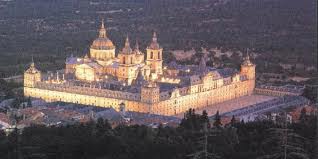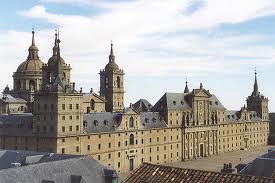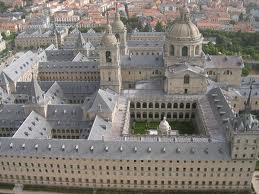Baroque: El Escorial

Little forms of artistic creation can differ more drastically than Plateresque and Classicist Renaissance in Spain. Thus, if a visit to Salamanca might well be the best way to fully perceive the full extent and richness of the unique architectural style that emerged in the country towards the beginning of the XVI century, then the masterpiece of Spanish classicist Renaissance art from the second half of the XVI century is, unequivocally, the Royal Seat of San Lorenzo de El Escorial.
Conceived by King Felipe II following the death of his father, the Holy Roman Emperor Charles V, El Escorial is a huge architectural complex that incorporates a monastery, a cathedral and a palace. The original layout of the complex was begun in 1561 by Juan Bautista de Toledo, an accomplished architect who had worked alongside Michelangelo in Rome, under Pope Paul III, as well as in Florence and in Naples.
It took Juan de Toledo a full year to carry out the design of the project, an ambitious blend of the courtly and the monastic life, annexed to the small village that already existed. Juan de Toledo's original plan contemplated some basic differences to the final result, including six more towers, halfway along the laterals of the facade, a round apse to the church and open courtyards before the basilica, which left the temple in full view of the people.
Juan de Herrera

Austere yet imposing, the project was begun in the chosen location near Madrid in 1563, just a few days before the resolutions of the Council of Trent. Juan de Toledo would only live to see a relatively small portion of it built, given that he would pass away in 1567, just four years later. Eventually, in 1572, the project would be put in the hands of Juan de Herrera's, Juan de Toledo's apprentice, who had been involved in the construction since from the beginning.
In the most rigorous accordance with the monastic tradition, El Escorial, despite being a Royal Seat, is strikingly sober to look at. Meant to house as many as 100 monks, the outer buildings cut a perfect square, four stories high, that enclose the inner lodgings of the complex, providing it with an impenetrable feeling, enhanced by the towers in the four corners of the square.
Once through the main entrance, the King's Courtyard opens splendidly, leading through a wide open space towards the kernel of the entire construction: the basilica. Far more luscious that the facade, the church dominates the courtyard with a colossal cupola reminiscent of St. Peter's in Rome and two striking belfries which rise cleanly to the skies, decorated only by the odd ball. From the outside, the building is most impressive for the cleanliness of its lines,, which award it an understated elegance.
In terms of its distribution, the basilica cuts a square within the greater square that is the complex as a whole. Outwardly, however, the roofs of the church have been extended to resemble a Latin cross, the shape stipulated by the Council of Trent for all churches to come. The ceilings are in barrel vaults, which all coincide in the open space in the middle, where the high cupola with its eight windows lets it copious amounts of natural light.

If the basilica is the central point of the complex, there are still some remarkable buildings worth mentioning. One of them in the library, which was included in the design by Juan de Herr era's when he altered the original conception by closing fully the atrium of the church and making the facade a complete square. Boasting marble floors, magnificent wooden shelves and frescoed barrel vaults, the library is home to over 40,000 books.
Next to the high altar is King Felipe's minimalist palace, but beyond the basilica there is the quaint cloister of the monastery, with the courtyard of the Evangelists in the middle, dominated by a beautiful pavilion, also Juan de Herrera's creation. And further still, the palace's garden open wide, offering a gorgeous combination of nature and tranquility for the prudent Felipe II.
The monastery of El Escorial is the perfect expression of the rigorous self-control that characterised Felipe II. It was the expression of that moment of transition from the Humanism of Renaissance to the conflicted consciousness of the Baroque. It was the climax of the Spanish Empire, and it was all, rather purely, expressed in Juan de Herrera's lifework. So if you happen to go to Madrid be sure to take the opportunity to visit one of the most extraordinary buildings in the world.
